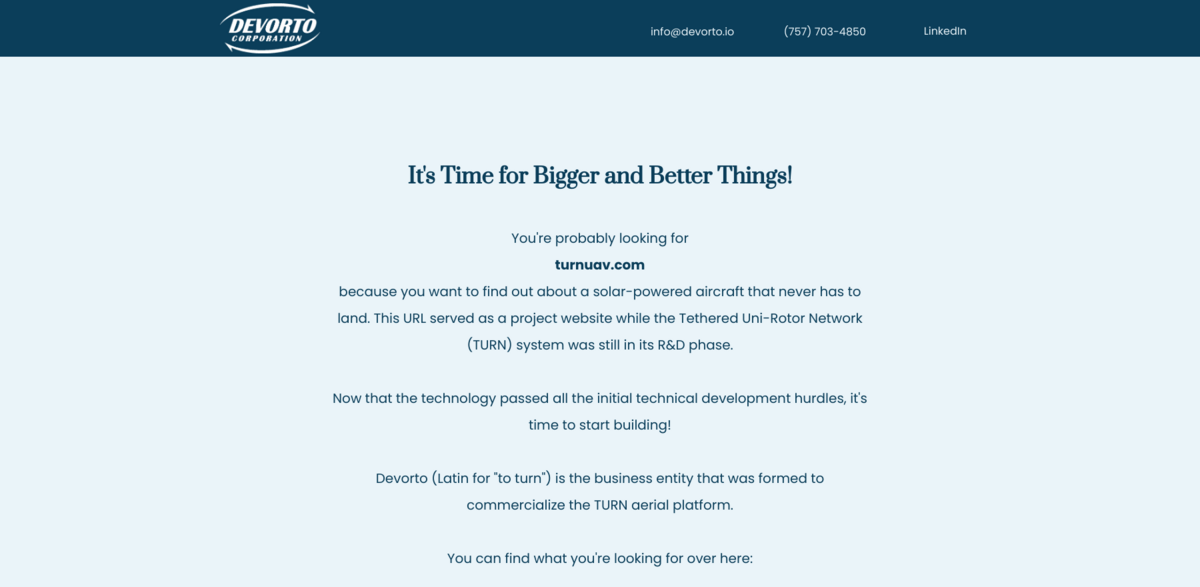What the Devorto Project Is
Devorto is building an aircraft that never has to land. This innovative, solar-powered aircraft collects enough energy during the day to remain aloft throughout the night, eliminating the need to land and refuel. Operating from the stratosphere, this system provides superior capabilities compared to satellites, but at a fraction of the cost and logistics challenges typically associated with a drone. The project’s long-term vision is to form the backbone of the next wireless telecommunications industry. Devorto—which means “to turn” in Latin—is the business entity established to commercialize the Tethered Uni-Rotor Network (TURN) aerial platform, a concept that is as bold as it is revolutionary… truly a new era for high-altitude engineering.
Main Benefit
The principal advantage of this concept lies in its extreme aerodynamic efficiency and the promise of drastically lower signal latency. Key figures and facts include:
- Provides the same array of services as traditional satellite networks with reduced cost and complexity.
- Operates on solar power, ensuring persistent flight even through the night.
- Delivers omnipresent communications, low signal latency for 5G relay stations, and broadband speed data rates for global Internet connectivity.
- Incorporates a design inspired by the limitations experienced by fixed-wing aircraft and NASA/Aerovironment Helios.
- Developed under the guidance of former NASA engineer Dr. Justin M Selfridge.
Innovative Aircraft Design
The TURN system is a paradigm shift in persistent flight. It combines the best features of both glider and helicopter designs, capturing their unique benefits while minimizing inherent drawbacks. At its core is a central hub that stores the vehicle’s payload. From this hub, several high tensile, small diameter cable tethers radiate outward. At the end of each cable, a satellite body is attached, each endowed with an airfoil lifting section, a propeller for propulsion, several control surfaces, and a fuselage that houses batteries, hardware, and sensors. This innovative approach not only addresses the aerodynamic and structural challenges but also sets the stage for functionalities that conventional aircraft simply cannot match… it’s quite the engineering marvel.
Engineering and Flight Mechanics
During flight, the system operates in a perpetual state of rotation. Each satellite body contributes to this rotation using its dedicated propulsion system, optimized with a specific twist and pitch corresponding to the vehicle’s angular velocity. Vertical translation is achieved with collective commands, where adjustments to throttle settings provide synchronous changes in velocity, thereby modulating the overall rotation rate of the TURN system. Horizontal translation, on the other hand, employs cyclic commands with sinusoidal control inputs distributed throughout each rotation. This dynamic combination facilitates precise maneuvering and represents a breakthrough in merging traditional flight techniques with modern technological innovations.
Commercial and Technological Impact
Persistent flight technology has widespread applications across multiple industries. The potential uses extend from replacing aging satellite networks to providing essential atmospheric monitoring for climate change and weather prediction. The design removes the risks and limitations associated with fixed-wing aircraft, allowing for a more flexible and responsive aerial system capable of offering black-box sensor payload functionalities. In addition, the TURN concept may serve as a low-cost, high-efficiency platform that supports telecommunications networks with lower signal latency and improved operational agility. The groundbreaking approach, recognized by its receipt of Small Business Innovation Research (SBIR) and Small Business Technology Transfer (STTR) grants sponsored by the US Air Force, underscores the transformative impact of this technology.
Project Impact
- SDG 7: Affordable and Clean Energy
- SDG 9: Industry, Innovation and Infrastructure
- SDG 11: Sustainable Cities and Communities
- SDG 13: Climate Action
- SDG 17: Partnerships for the Goals
Future Prospects and Global Relevance
Looking ahead, the TURN system promises a world where persistent flight enables not only omnipresent communications but also robust atmospheric monitoring and low-latency data connectivity worldwide. With a hybrid design approach that marries the stability of a glider with the agility of a helicopter, the system answers the growing need for on-demand services delivered in real-time. As the global appetite for improved surveillance capabilities, instant access to information, and comprehensive environmental monitoring increases, this novel solution positions itself as a critical enabler for future telecommunications and observational networks. The entire concept is a testament to innovative thinking and a bold departure from traditional aircraft design—openly challenging established norms while paving the way for sustainable and efficient aerial technologies… a promising leap forward for the entire industry.





















